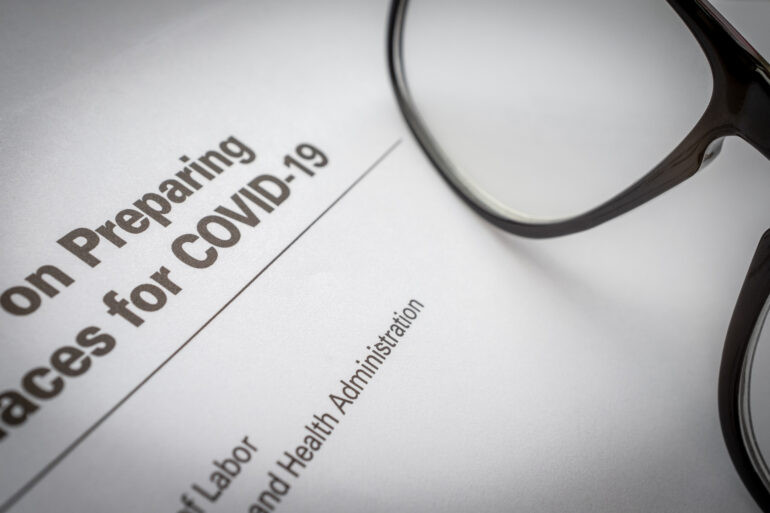The Supreme Court ruling on 1/13/2022 does not end vaccine mandates, it changes how they will be regulated and enforced. The following days will offer additional information regarding best practices, but in its current state any company mandates will be the responsibility of the business to manage individual policies.
Though the Supreme Court has ruled against Government enforced vaccine mandates, the high court has still upheld mandates for private businesses and universities in the past months. There is still a need to act responsibly and protect everyone as much as we can.
That being said, a company can and should continue to practice a protocol that will enhance safety while also continuing to monitor and react to information as it is updated.
CDC Guidance: Positive test, direct exposure or symptoms
If you test positive for Covid-19 — Everyone, regardless of vaccination status.
- Stay home for 5 days.
- If you have no symptoms or your symptoms are resolving after 5 days, you can leave your house.
- Continue to wear a mask around others for 5 additional days.
- *If you have a fever, continue to stay home until your fever resolves.
If you were exposed to someone with Covid-19
If you: Have been boosted
OR-Completed the primary series of Pfizer or Moderna vaccine within the last 6 months
OR-Completed the primary series of J&J vaccine within the last 2 months
- Wear a mask around others for 10 days.
- Test on day 5, if possible.
- *If you develop symptoms get a test and stay home.
If you: Completed the primary series of Pfizer or Moderna vaccine over 6 months ago and are not boosted
OR – Completed the primary series of J&J over 2 months ago and are not boosted
OR – Are unvaccinated
- Stay home for 5 days. After that continue to wear a mask around others for 5 additional days.
- If you can’t quarantine you must wear a mask for 10 days.
- Test on day 5 if possible.
- *If you develop symptoms get a test and stay home
OSHA Guidance: Positive test, direct exposure or symptoms
Note: OSHA has revised its enforcement guidance for recording cases of Covid-19.
All employers, regardless of industry should take action to determine whether employee COVID-19 illnesses are work-related and thus recordable on the OSHA 300 log.
COVID-19 is a recordable illness and employers are responsible for recording cases of COVID-19 on the 300 log if the following apply:
- The case is a confirmed case of COVID-19, as defined by the Centers for Disease Control and Prevention (CDC).
- The case is work-related as defined by (See Below clarification to work related)
OSHA Compliance and Safety Officers (CSHOs) have been directed to consider the following criteria in determining the work-relatedness of an employee’s COVID-19 illness:
- The reasonableness of the employer’s investigation into work-relatedness. Employers, especially small employers, should not be expected to undertake extensive medical inquiries, given employee privacy concerns and most employers’ lack of expertise in this area. It is sufficient in most circumstances for the employer, when it learns of an employee’s COVID-19 illness, to 1) ask the employee how he believes he contracted the illness; 2) while respecting employee privacy, discuss with the employee his work and out-of-work activities that may have led to the illness; and 3) review the employee’s work environment for potential SARS-CoV-2 exposure. This review of the work environment should be informed by any other instances of workers in that environment contracting the COVID-19 illness.
- The evidence available to the employer. The evidence that a COVID-19 illness was work-related should be considered based on the information reasonably available to the employer at the time it made its work-relatedness determination. If the employer later learns more information related to an employee’s COVID-19 illness, then that information should be taken into account as well in determining whether an employer made a reasonable work-relatedness determination.
- The evidence that a COVID-19 illness was contracted at work. CSHOs should take into account all reasonably available evidence, in the manner described above, to determine whether an employer has complied with its recording obligation. This cannot be reduced to a ready formula, but certain types of evidence may weigh in favor of or against work-relatedness. For instance:
- COVID-19 illnesses are likely work-related when several cases develop among workers who work closely together and there is no alternative explanation.
- An employee’s COVID-19 illness is likely work-related if it is contracted shortly after lengthy, close exposure to a particular customer or co-worker who has a confirmed case of COVID-19 and there is no alternative explanation.
- An employee’s COVID-19 illness is likely work-related if his job duties include having frequent, close exposure to the general public in a locality with ongoing community transmission and there is no alternative explanation.
- An employee’s COVID-19 illness is likely not work-related if she is the only worker to contract COVID-19 in her vicinity and her job duties do not include having frequent contact with the general public, regardless of the rate of community spread.
- An employee’s COVID-19 illness is likely not work-related if he closely and frequently associates with someone outside the workplace (e.g., a family member, significant other or close friend) who 1) has COVID-19, 2) is not a co-worker and 3) exposes the employee during the period in which the individual is likely infectious.
- CSHOs should give due weight to any evidence of causation pertaining to the employee illness at issue provided by medical providers, public health authorities or the employee herself.
*If, after the reasonable and good-faith inquiry described above, the employer cannot determine whether it is more likely than not that exposure in the workplace played a causal role with respect to a particular case of COVID-19, the employer does not need to record that COVID-19 illness.
Reporting COVID-19 fatalities and hospitalizations to OSHA. The Emergency temporary standard requires employers to report work-related COVID-19 fatalities to OSHA within 8 hours of learning about them, and work-related COVID-19 in-patient hospitalizations within 24 hours of the employer learning about the hospitalization.
- www.osha.gov
- (800)-321-OSHA (6742)
Additionally, from May 21, 2021 through at least May 22, 2022, an adverse reaction to a COVID-19 vaccine is not a recordable injury.
Source: CentricHC










